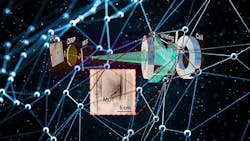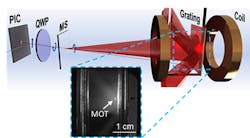Researchers at the National Institute of Standards and Technology (NIST) have reduced the size of the optical components needed to cool atoms down to a few thousandths of a degree Celsius above absolute zero, shrinking them from the size of a dining room table to that of a thin shoebox. They must still be made one-tenth that size to comfortably fit on chips, but it is the first step in using super-cooled atoms in chips for more-accurate atomic clocks and navigation devices independent of GPS, as well as simulating quantum devices and computers.
Cooling atoms slows them from their room-temperature speeds close to the speed of sound (1,125 fps) down to 0.33 fps. This makes them easier to observe and study. At room temperature, atoms only have fleeting interactions with other particles and they very quickly transition from one energy level to another. When atoms are slowed down, researchers can more easily measure their energy transitions and other quantum properties accurately enough to use as reference standards.
Engineers have been cooling atoms by bombarding them with a laser beam. Although lasers ordinarily energize atoms and accelerate their motion, it was discovered 20 years ago that a laser can slow them down if its frequency and other properties are properly tuned. The adjusted laser’s photons hit the atoms and reduce their speed and momentum until they are going so slowly, they can be captured in a magneto-optical trap (MOT).
The new cooling device uses planar optics and is about 6 in. long. Planar or flat optics have the advantage of being easy to mass-produce. The device cools and traps gaseous atoms in a space about 0.4 in. wide.
In the planar device, an extreme mode converter—an optical IC—increases the width of a 500-nm wide laser beam by a factor of 280. The wider beam then strikes an ultrathin film, or “metasurface,” that measures 600 nm long and 100-nm wide. It is covered with pillars that widen the beam again, this time by a factor of 100. Widening the beam lets it efficiently cool more atoms.
The metasurface and its pillars also change the laser beam’s intensity and polarization (direction of vibration). A laser’s intensity traditionally follows a bell-shaped curve, with the brightest light at the center of the beam and the brightness tapering off on either side. The NIST nanopillars create a more uniform brightness across the beam’s entire width. The uniform brightness and the polarization increase the beam’s efficiency at cooling atoms.
The expanding, reshaped beam cools the atoms and then hits a diffraction grating that splits the single beam into three pairs of equal and oppositely directed beams. The beams are redirected so that they push on the atoms in opposite directions. The beams and the MOT’s magnetic field keep the cooled atoms trapped.
The goal of the project is to further shrink the laser-preparation apparatus and make it less complicated, so it can be put on chips and work outside of laboratories.

